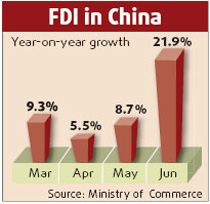China's e-mail users may one day have to stick a cyber stamp on their missives as the nation's Internet regulator pushes for development of an electronic postal system.
The aim is not to raise revenue from postage charges but to fight the increase in junk mail, according to the China Internet Conference, the largest annual gathering for the country's Internet industry, which concluded on Wednesday.
"We are working with several institutes on development of e-mail stamp technology," Wang Xiujun, a member of the Anti-Spam Working Committee under the Internet Society of China, told a forum in Kunshan in Jiangsu Province.
"It can help filter out spam mail from the source before it is sent out."
The e-stamp system would amount to an electronic mark implanted within an e-mail, containing information that could be used to identify the sender.
Ordinary users wouldn't notice any difference, as only third-party organizations such as the anti-spam committee or government bodies would be able to decode and trace the mailer.
The benefit for e-mail users: the e-stamp would allow their mail to move faster through a "green passage" on the Web, and they wouldn't need to worry about being mistakenly blocked by the receiver.
As the technology is still under development, it is too early to tell whether users would have to pay "postage." But the system would increase costs for e-mail service providers and broadband operators, said Zhang Yueping, also a member of the anti-spam committee.
Senders of junk mail face fines up to 30,000 yuan (US$3,947), according to an e-mail service regulation enacted in March last year.
But the sanctions have had little effect on spammers so far, who often change their Internet addresses and are difficult to trace.
The anti-spam committee has set up an online reporting platform to receive complaints and publish blacklists of Internet addresses charged with spamming. Many small businesses are using the aggressive, low-cost marketing strategy aimed at stuffing mail boxes with all kinds of advertisements.
Spam mail accounted for 58 percent of all messages received by Chinese e-mail users in the second quarter. Most of the mail promoted online shopping, schemes to make money on the Internet, sex toys or drugs. Those categories accounted for nearly 40 percent of all junk messages. Even worse, 11 percent of the spam also contained computer viruses, according to the Internet Society of China.
Though still serious, the 58-percent figure marked a six percentage point drop from the first quarter of 2006, the most obvious improvement among all countries in the period, said the ISC's Wang.
Several e-mail service providers contacted by Shanghai Daily yesterday seeking comments on the e-stamp were cautious.
"It should be something like a commercial alliance, but its direction and outlook are difficult to assess at present," Sina.com, China's largest portal, said in a statement.
NetEase.com, China's largest e-mail service provider, declined to comment.
"The proposal would require coordination between all the interest groups in the e-mail industry," said the ISC's Zhang. "They would be concerned about how to earn a return on the additional investment."
(Shanghai Daily September 28, 2007)


